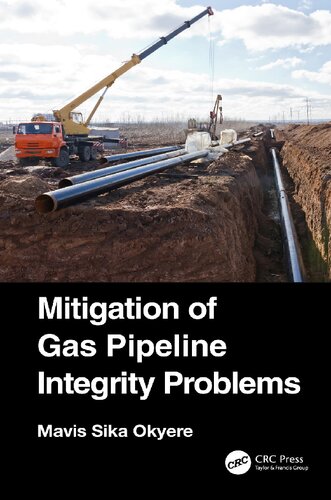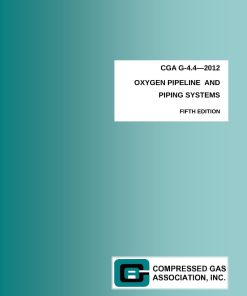Mitigation of Gas Pipeline Integrity Problems 1st Edition by Mavis Sika Okyere ISBN 0367546582 9780367546588
$50.00 Original price was: $50.00.$25.00Current price is: $25.00.
Mitigation of Gas Pipeline Integrity Problems 1st Edition by Mavis Sika Okyere – Ebook PDF Instant Download/Delivery: 0367546582 ,9780367546588
Full download Mitigation of Gas Pipeline Integrity Problems 1st Edition after payment

Product details:
ISBN 10: 0367546582
ISBN 13: 9780367546588
Author: Mavis Sika Okyere
Mitigation of Gas Pipeline Integrity Problems 1st Edition Table of contents:
Chapter 1 Introduction
Chapter 2 Third-Party Damage
2.1 Introduction
2.2 Mitigation
2.2.1 Public Awareness
2.2.2 Routing
2.2.2.1 Route Selection
2.2.3 Burial Depth: Increased Depth of Burial
2.2.4 Additional Protection
2.2.5 Pipeline Surveillance
2.2.6 Improve Signage
2.2.7 Right-of-Way Intrusion Detection
2.2.8 Notification System
2.2.9 Safety Management
2.2.10 Design Factor
2.3 Mitigating Third-Party Damage to Aboveground Pipelines
2.3.1 Case Study: Another Sabotage? Gas Pipelines at Tema Torched by Suspected Arsonists
2.3.1.1 How Do We Avoid Such Incidents?
2.3.1.2 How Do We Fix the Damaged Pipe?
Chapter 3 Corrosion
3.1 Corrosion Mechanism
3.1.1 Basics of Aqueous Metallic Corrosion
3.1.2 Forms of Corrosion
3.1.3 Polarization and Corrosion Rates
3.1.3.1 Concept of Polarization
3.1.3.2 Corrosion Rate
3.1.3.3 Factors Affecting Corrosion Rate
3.1.4 Hydrogen – Release Corrosion and Oxygen-Consumption Corrosion
3.1.4.1 Hydrogen – Release Corrosion
3.1.4.2 Oxygen-Consumption Corrosion
3.1.5 Causes of Corrosion
3.1.5.1 Corrosive Environments
3.2 External Corrosion Mitigation
3.2.1 Materials Selection
3.2.1.1 Considerations for Material Selection
3.2.1.2 Materials with High Corrosion Resistance
3.2.2 Protective Coatings
3.2.2.1 Coal Tar and Asphalt Coatings
3.2.2.2 Fusion-Bonded Epoxy Coatings
3.2.2.3 Polyethylene Coatings
3.2.2.4 Tape Wrap
3.2.2.5 Epoxy and Urethane Liquid Coatings
3.2.2.6 Coal Tar Epoxy Coatings
3.2.2.7 Mill-Applied Tape Coating Systems
3.2.2.8 Extruded Polyolefin Systems
3.2.2.9 Crosshead-Extruded Polyolefin with Asphalt/Butyl Adhesive
3.2.2.10 Dual-Side-Extruded Polyolefin with Butyl Adhesive
3.2.2.11 Multi-Layer Epoxy/Extruded Polyolefin Systems
3.2.2.12 Elastomer Coatings
3.2.2.13 High-Temperature Coatings
3.2.2.14 Foam Materials
3.2.2.15 Epoxy Phenolic Coatings
3.2.2.16 Epoxy Novolac Coatings
3.2.2.17 Silicone Coatings
3.2.2.18 Modified Silicone Coatings
3.2.2.19 Multi-Polymeric Matrix Coatings
3.2.2.21 Galvanic Zinc Application
3.2.3 Cathodic Protection
3.2.3.1 General
3.2.3.2 Main Parameters of Cathodic Protection
3.2.3.3 Sacrificial Anode Cathodic Protection System
3.2.3.4 Impressed Current Cathodic Protection System
3.2.3.5 Offshore Cathodic Protection
3.2.3.6 Onshore Cathodic Protection
3.2.3.7 Satisfying the Current Output Requirement
3.2.3.8 Additional Requirements
3.2.3.9 Shielding of Cathodic Protection Current
3.2.4 Design Detailing
3.2.5 Common Contributing Factors to External Corrosion
3.2.6 External Corrosion Mitigation – Design and Construction
3.2.6.1 External Corrosion Mitigation – Operation
3.2.6.2 Corrosion Monitoring Techniques
3.2.6.3 External Corrosion Inspection Techniques
3.3 Internal Corrosion Mitigation
3.3.1 Contributing Factors to Internal Corrosion in Gas Pipeline Systems
3.3.2 Recommended Practices for Mitigating Internal Corrosion
3.3.3 Practices for Mitigating Internal Corrosion – Operation
3.3.3.1 Product Monitoring
3.3.3.2 Internal Coatings
3.3.3.3 Chemical Injection
3.3.3.4 Dehydration
3.3.3.5 Cleaning Pigs
3.3.3.6 Buffering
3.3.3.7 Corrosion Monitoring Techniques
3.3.3.8 Corrosion Inspection Techniques
3.3.4 Mitigation of Internal Corrosion in Carbon Steel Oil-Effluent Pipeline Systems
3.3.4.1 Corrosion Mechanisms and Mitigation
3.3.4.2 Recommended Practices
3.3.4.3 Corrosion Mitigation Techniques
3.3.4.4 Corrosion Monitoring Techniques
3.3.4.5 Corrosion Inspection Techniques
3.3.4.6 Repair and Rehabilitation Techniques
3.4 AC Corrosion Mitigation
3.4.1 AC Corrosion Mitigation Approaches
3.4.1.1 Decoupler
3.5 Stray Current Corrosion Mitigation
3.5.1 Stray Current Sources
3.5.2 Stray Current Corrosion Prevention
3.5.2.1 Construction Technique
3.5.2.2 Corrosion and Prevention of DC Stray Current
3.5.2.3 AC Interference Hazards and Protection
3.6 Stress Corrosion Cracking
3.6.1 Mitigation of Stress Corrosion Cracking of Pipelines
3.6.1.1 Material Selection
3.6.1.2 Environment
3.6.1.3 Stress
3.6.1.4 Coating
3.6.1.5 Cathodic Protection
3.7 Mitigation of Hydrogen-Induced Cracking
3.8 Mitigation of Sulfide Stress Cracking
3.9 How to Find Corrosion
3.9.1 Internal Inspection
3.9.1.1 In-line Inspection
3.9.2 External Inspection
3.9.2.1 Visual Inspection
3.9.2.2 Pipe-to-Soil Readings
3.9.2.3 Drone/Robot Technology
3.9.3 Mandatory Monitoring
3.9.3.1 Supplemental Integrity Monitoring
3.10 What to Do When Corrosion Is Found
3.10.1 Pipeline Repair Standard
3.10.1.1 Corrosion
3.10.2 Repair Methods
3.10.2.1 Dig and Replace
3.10.2.2 Composite Sleeve
3.10.2.3 Full Encirclement Steel Sleeves
3.10.2.4 Weld Deposition Repair
3.10.2.5 Grinding
3.10.2.6 Hot Tapping
3.10.2.7 Wraps
3.10.2.8 Clamping
3.10.2.9 Dig and Recoat
3.10.2.10 Choosing the Most Appropriate Method of Repair
Chapter 4 Construction and Materials Defect
4.1 Quality Control Program
4.1.1 QA/QC Program Administration and Documentation
4.1.1.1 Management Commitment and Responsibility
4.1.1.2 Materials
4.1.1.3 Design Codes and Standards
4.1.1.4 Quality Inspections
4.1.1.5 Workmanship
4.1.1.6 Documentation and Retention of Documentation
4.1.2 Subcontractor Evaluation and Selection
4.1.2.1 Contractor and Consultant Competency and Procurement
4.1.3 Contractual Risk Transfer
4.2 Quality Assurance of Pipeline Design
4.2.1 Design Factor
4.2.2 Design Criteria
4.2.2.1 Stresses
4.2.2.2 Fatigue Life
4.2.2.3 Expansion and Flexibility
4.2.3 Materials
4.2.3.1 Wall Thickness
4.2.3.2 Material Properties
4.2.3.3 Material Selection
4.3 Quality Control of Pipeline Construction
4.3.1 Pipe Jointing
4.3.2 Mitigation from Improper Design or Materials Selection during Operation
Chapter 5 Geotechnical Hazards
5.1 Mitigation of Geotechnical Hazards
5.1.1 Geotechnical Investigation
5.1.2 Geohazard Assessment
5.1.3 Re-routing
5.1.4 Strain-Based Design
5.1.4.1 Determination of Component of Strain
5.1.4.2 Buckling
5.1.5 Scheduling
5.2 Mitigation from External Forces
Chapter 6 Off-Spec Natural Gas
6.1 Introduction
6.2 Natural Gas Specifications
6.2.1 Hydrocarbon Dewpoint
6.2.2 Water Dewpoint (Moisture)
6.2.3 Carbon Dioxide
6.2.4 Oxygen
6.2.5 Hydrogen Sulfide
6.2.6 Total Sulfur
6.2.7 Temperature
6.2.8 Gas Interchangeability
6.2.9 Calorific Value
6.2.10 Relative Density
6.2.11 Wobbe Number
6.2.12 Relative Humidity
6.2.13 Compressibility Factor (Z)
6.2.13.1 Compressibility Factors at Standard Conditions
6.3 Adjustment of Gas Quality
6.4 Properties Relevant to Liquefaction
6.5 The More Important Gas Characteristics
Chapter 7 Natural Gas Hydrate
7.1 Introduction
7.2 Structure of Gas Hydrate
7.2.1 Types of hydrates
7.3 Conditions Necessary for Hydrate Formation
7.4 Prediction of Hydrate Formation Condition
7.4.1 Prediction from Gas Gravity
7.4.1.1 Example Calculation
7.4.2 Prediction Using Vapor–Solid Equilibrium Constants
7.4.2.1 Example Calculation
7.4.3 Predict gas hydrate formation temperature with a simple correlation
7.4.4 Commercial computer programs
7.5 Water Content of a Natural Gas Stream
7.5.1 Example Calculation of Water Dropout in a Natural Gas Transmission Pipeline
7.6 Methods of Hydrate Prevention and Mitigation
7.6.1 Hydrate Inhibitors
7.6.1.1 Methanol Injection
7.6.1.2 Glycol Injection
7.6.2 Glycol Dehydration
7.6.2.1 Water Removal
7.6.3 Low Pressure Operation
7.6.4 Insulation
7.6.5 Active heating
7.7 Prevention of Hydrate Formation during Commissioning
7.7.1 Pipelines
7.7.2 Spool Pieces
7.8 Removing Hydrates
7.8.1 Injection of Hydrate Point Depressant
7.8.1.1 Determination of Total Inhibitor Required
Chapter 8 Leak and Break Detection
8.1 Introduction
8.2 Leak Detection Methods
References
Index
People also search for Mitigation of Gas Pipeline Integrity Problems 1st Edition:
pipeline integrity threats
pipeline integrity management pdf
pipeline integrity program
pipeline integrity mega rule
pipeline integrity management program
Tags: Mavis Sika Okyere, Mitigation, Gas Pipeline, Integrity Problems
You may also like…
Fiction - Short Stories
Short Stories 1st Edition by Calanthe Mavis 1005746532 9781005746537
Animals & Pets - Animals
Sika Deer: Life History Plasticity and Management Koichi Kaji
Technique - Fuel Technology
Earth Sciences - The Environment











